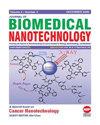激活红细胞核因子 2 相关因子 2 可拮抗活性氧调节因子 1 诱导的核浆细胞氧化应激
IF 2.9
4区 医学
Q1 Medicine
引用次数: 0
摘要
本研究探讨了活性氧调节因子1(ROMO1)在髓核(NP)细胞内氧化应激中的作用及其受核因子红细胞2相关因子2(Nrf2)的潜在调控。收集患者的椎间盘样本,分析 ROMO1、Nrf2 和胶原 I/II 的水平,以确定它们之间的潜在联系。培养人类 NP 细胞并将其暴露于 H2O2 以诱导氧化应激。为了阐明 ROMO1 对 NP 细胞新陈代谢的影响,NP 细胞转染了 ROMO1。同时,在培养过程中使用 Nrf2 激活剂和抑制剂来调节 Nrf2 的表达。氧化应激通过 CAT 和 SOD1 基因表达分析以及细胞活性氧(ROS)生成测量进行评估。通过评估细胞活力和胶原蛋白 I/II 的表达来确定 NP 细胞状态。结果表明,在严重的椎间盘变性(IDD)和经 H2O2 处理后,ROMO1 表达升高。ROMO1 的过表达增加了 ROS 的产生,抑制了 CAT、SOD 和胶原蛋白 II 的表达,同时升高了胶原蛋白 I 并对细胞活力产生了负面影响。然而,激活 Nrf2 能有效抑制 ROMO1 的表达,保护 NP 细胞免受 H2O2 或 ROMO1 诱导的氧化应激。总之,ROMO1 会加剧氧化应激并导致 NP 细胞变性,而 Nrf2 的活化可减轻这一过程。本文章由计算机程序翻译,如有差异,请以英文原文为准。
Activation of Nuclear Factor Erythroid 2-Related Factor 2 Antagonizes the Reactive Oxygen Species Modulator 1-Induced Oxidative Stress in Nucleus Pulposus Cells
This study investigates the role of Reactive Oxygen Species Modulator 1 (ROMO1) in oxidative stress within nucleus pulposus (NP) cells and its potential regulation by Nuclear factor erythroid 2-related factor 2 (Nrf2). Intervertebral disc samples from patients were collected, and ROMO1,
Nrf2, collagen I/II levels were analyzed to establish their potential connection. Human NP cells were cultured and exposed to H2O2 to induce oxidative stress. To elucidate ROMO1’s impact on NP cell metabolism, NP cells were transfected with ROMO1. Concurrently,
Nrf2 activators and inhibitors were used to modulate Nrf2 expression during culturing. Oxidative stress was assessed through CAT and SOD1 gene expression analysis and measurement of cellular reactive oxygen species (ROS) production. NP cell status was determined by evaluating cell viability
and collagen I/II expression. Results indicated elevated ROMO1 expression in severe intervertebral disc degeneration (IDD) and after H2O2 treatment. ROMO1 overexpression increased ROS production, suppressed CAT, SOD, and collagen II expression, while elevating collagen I and negatively affecting
cell viability. However, Nrf2 activation effectively suppressed ROMO1 expression and protected NP cells from oxidative stress induced by H2O2 or ROMO1. In conclusion, ROMO1 exacerbates oxidative stress and contributes to NP cell degeneration, a process mitigated by Nrf2
activation.
求助全文
通过发布文献求助,成功后即可免费获取论文全文。
去求助
来源期刊
CiteScore
4.30
自引率
17.20%
发文量
145
审稿时长
2.3 months
期刊介绍:
Information not localized

 求助内容:
求助内容: 应助结果提醒方式:
应助结果提醒方式:


